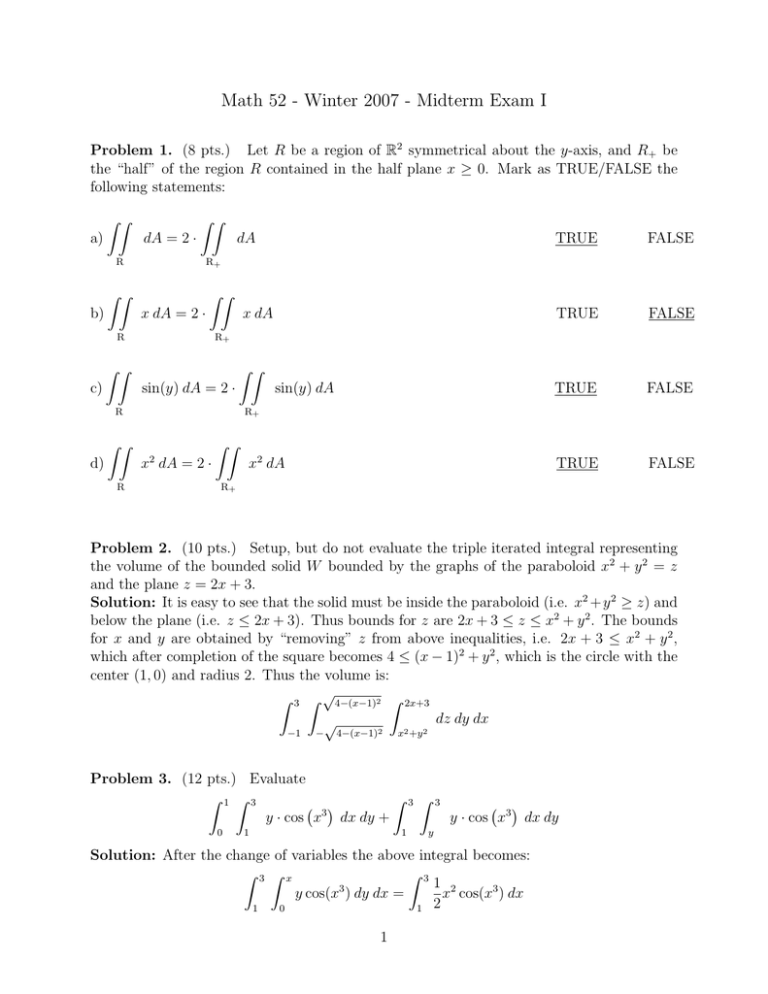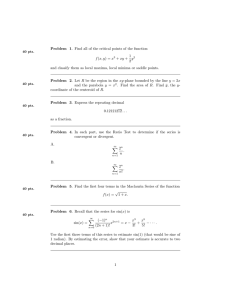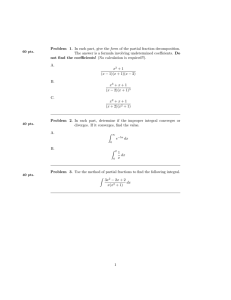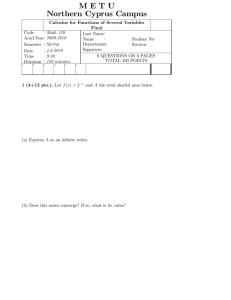Math 52 - Winter 2007 - Midterm Exam I
advertisement

Math 52 - Winter 2007 - Midterm Exam I
Problem 1. (8 pts.) Let R be a region of R2 symmetrical about the y-axis, and R+ be
the “half” of the region R contained in the half plane x ≥ 0. Mark as TRUE/FALSE the
following statements:
ZZ
ZZ
dA = 2 ·
a)
R
dA
R
x dA
R
sin(y) dA
FALSE
TRUE
FALSE
R+
2
ZZ
x dA = 2 ·
R
TRUE
ZZ
sin(y) dA = 2 ·
d)
FALSE
R+
ZZ
ZZ
TRUE
ZZ
x dA = 2 ·
c)
FALSE
R+
ZZ
b)
TRUE
x2 dA
R+
Problem 2. (10 pts.) Setup, but do not evaluate the triple iterated integral representing
the volume of the bounded solid W bounded by the graphs of the paraboloid x2 + y 2 = z
and the plane z = 2x + 3.
Solution: It is easy to see that the solid must be inside the paraboloid (i.e. x2 + y 2 ≥ z) and
below the plane (i.e. z ≤ 2x + 3). Thus bounds for z are 2x + 3 ≤ z ≤ x2 + y 2 . The bounds
for x and y are obtained by “removing” z from above inequalities, i.e. 2x + 3 ≤ x2 + y 2 ,
which after completion of the square becomes 4 ≤ (x − 1)2 + y 2 , which is the circle with the
center (1, 0) and radius 2. Thus the volume is:
Z Z √
2 Z
4−(x−1)
3
−1
−
√
2x+3
dz dy dx
4−(x−1)2
x2 +y 2
Problem 3. (12 pts.) Evaluate
Z 1 Z 3
Z
3
y · cos x dx dy +
0
1
1
3
Z
3
y · cos x3 dx dy
y
Solution: After the change of variables the above integral becomes:
Z 3 Z x
Z 3
1 2
3
y cos(x ) dy dx =
x cos(x3 ) dx
1
0
1 2
1
After substitution u = x3 this gives
1
6
(sin 27 − sin 1)
Problem 4. (12 pts.) Change the order of integration in
Z
2
x2
Z
sin(x + 3y) dy dx
−1
0
DO NOT EVALUATE THE INTEGRAL
Solution: The region of integration is not horizontally simple, thus we need to use the sum
of two integrals:
Z 4 Z 2
Z 1 Z −√y
sin(x + 3y) dx dy +
sin(x + 3y) dx dy
√
0
−1
0
y
Problem 5.
1. (4 pts.) Sketch the region in the xy−plane described by the inequality
|x| + |y| ≤ 1
Solution: The region is a square with vertices (1, 0), (0, 1), (−1, 0), (0, −1).
2. (6 pts.) Show that
Z1
ZZ
f (x + y) dx dy =
f (t) dt,
−1
|x|+|y|≤1
for any continuous real-valued function f .
Hint: Perform some change of variables...
Solution: Set u = x + y and v = x − y. The first variable is kind of obvious from
the statement of the problem, the second is suggested by the boundaries of the region of
integration. Then the square over which we integrate is −1 ≤ u ≤ 1 and −1 ≤ v ≤ 1. The
Jacobian is:
1 1 ∂(u, v)
= −2
= det 1 −1 ∂(x, y)
Thus
Z1 Z1
ZZ
f (x + y) dx dy =
|x|+|y|≤1
1
f (u) · dv du =
2
−1 −1
Z1
1
· 2f (u) du
2
−1
Problem 6. (12 pts.)
Consider the region W on xyz space defined by inequalities:
1 ≤ x ≤ 2, 0 ≤ xy ≤ 2, 0 ≤ z ≤ 1.
∂(x, y, z)
a) Find the Jacobian
, where u = x, v = xy and w = z.
∂(u, v, w)
2
Solution:
1 0 0
∂(u, v, w)
= det y x 0
∂(x, y, z)
0 0 1
Thus
=x=u
∂(x, y, z)
1
=
∂(u, v, w)
u
b) Evaluate the integral
ZZZ
(x2 y + 3xyz) dx dy dz
W
by applying the above change of coordinates.
Solution: After the change of variables the integral becomes:
Z2 Z2 Z1
1
0
1
(uv + 3vw) · dw dv du =
u
0
Z2
Z2
du ·
1
Z1
v dv ·
0
Z2
dw +
0
1
du ·
u
1
Z2
Z1
3v dv ·
0
w dw =
0
= 2 + ln 8
Problem 7. (12 pts.) Find the coordinatespof the centroid of the solid in the first octant
that is bounded from above by the cone z = x2 + y 2 , below by the z = 0 and on the sides
by the cylinder x2 + y 2 = 4. (It is part of a cylinder hollowed out by a cone)
Hint 1: use cylindrical coordinates.
Use: The volume of a cylinder with radius of the base r and the height h is πr2 h. The
volume of a the cone with radius of the base r and the height h is 31 πr2 h. Use these to find
the total mass of your solid.
Solution: By symmetry x̄ = ȳ.
The total mass can be computed as 1/4 of the volume of the cylinder (π22 · 2) minus the
volume of the cone ( 31 π22 · 2). Thus the mass is 43 π.
Zπ/2 Z2 Zr
ZZZ
m · x̄ =
r cos θ · r dz dr dθ = 4
x dV =
0
V
0
0
Thus x̄ = ȳ = π3 . Similarly:
Zπ/2 Z2 Zr
ZZZ
m · z̄ =
z · r dz dr dθ = π
x dV =
V
0
0
0
Thus z̄ = 34 .
Problem 8. (12 pts.) Let S be the part of the ball x2 + y 2 + z 2 ≤ r2 that lies above the
xy plane. Find the moment of inertia of S about the z axis.
3
Hint: use spherical coordinates.
R π/2
Use: 0 sin3 x dx = 23 .
Solution:
ZZZ
Iz =
V
x2 + y 2 dV =
Z2π Zπ/2 Zr
0
0
(ρ sin φ)2 ρ2 sin φ dρ dφ dθ =
4πr5
15
0
Problem 9. (12 pts.) Assume that a region R with density ρ ≡ 1 in the xy coordinates
is symmetrical about the x axis. Show that
I(0,b) = I(0,0) + m · b2
where I(a,b) is the moment of inertia about an axis perpendicular to xy plane at the point
(a, b) and m is the total mass of the region.
Solution: By the symmetry ȳ = 0. Then we have:
ZZ
ZZ
ZZ
ZZ
2
2
2
2
2
I(0,b) =
x + (y − b) dA =
x + y dA −2b
dA
y dA +b
R
|R
{z
I(0,0)
4
}
| R {z
ȳ=0
}
| R {z }
m




